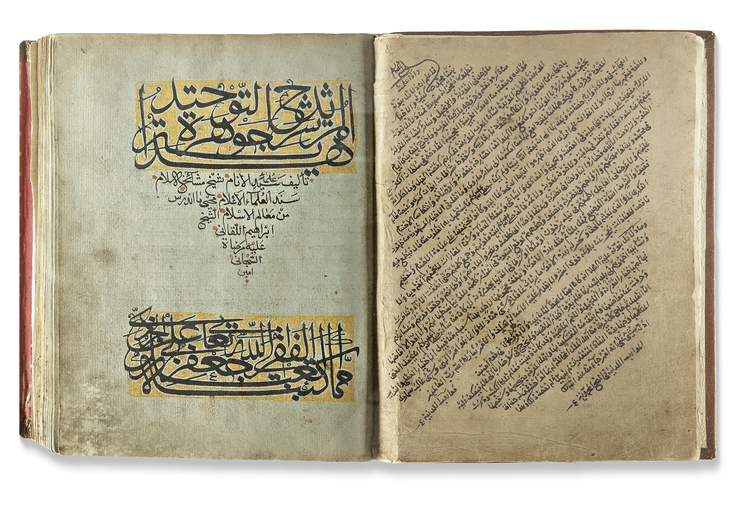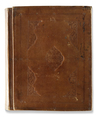Lot 208 THEOLOGICAL AND JURISPRUDENTIAL TREATISES, NEAR EAST WRITTEN BETWEEN 1215 AH AND 1218 AH (1800–1803 AD).
Arabic manuscript on paper
Each page contains 23 lines, written in a small black script, with titles and significant words highlighted in red ink. The manuscript comprises various treatises on theology and Islamic jurisprudence (Fiqh), written at different times between 1215 AH and 1218 AH (1800–1803 AD).
In brown morocco leather binding with flap.
17 by 22 cm.
Jawharat al-Tawḥīd
Comprising 204 leaves, this work was authored in 1215 AH by the eminent scholar Imam al-Laqqānī. He is widely renowned for this didactic poem, Jawharat al-Tawḥīd ("The Gem of Monotheism"), which gained more acclaim than any of his other works. The poem serves as a foundational theological treatise, presenting the core tenets of Islamic belief according to the methodology of Ahl al-Sunnah wal-Jamāʿah.
Rooted in the teachings of Imam Abū al-Ḥasan al-Ashʿarī (may Allah have mercy on him), this methodology upholds a rational yet traditional approach, aligning closely with the doctrines of the pious predecessors (al-salaf al-ṣāliḥ), including the Companions, Followers, and their successors. The poem is notable for its precise expression of creed, faithful to the Qur’an and Sunnah, and its rigorous intellectual defense of orthodox beliefs.
Interestingly, Imam al-Laqqānī himself was the first to write a commentary on Jawharat al-Tawḥīd, referencing multiple interpretations he had authored on his own poem—demonstrating the significance he attributed to the work.
Al-ʿAqd al-Farīd fī Aḥkām al-Taqlīd
Written in 1218 AH, this treatise by Imam al-Samhūdī is a distinguished exploration of taqlīd (legal adherence to qualified scholarship). The work integrates perspectives from both jurisprudence (fiqh) and legal theory (uṣūl al-fiqh), creating a sophisticated synthesis of foundational principles and applied legal reasoning. Drawing from classical legal texts, Imam al-Samhūdī bridges abstract theory with real-world jurisprudential issues—making the treatise a valuable resource for scholars engaged in both fields.
Al-Qawl al-Sadīd fī Baʿḍ Masāʾil al-Ijtihād wa al-Taqlīd
Authored in 1214 AH (1799/1800 CE) by Muḥammad ʿAbd al-ʿAẓīm al-Makkī al-Ḥanafī, this work also addresses the complex relationship between ijtihād (independent legal reasoning) and taqlīd. Notably, the author is recorded as having served as Imam of Masjid al-Ḥaram in Mecca, lending considerable scholarly weight to the treatise. It is thought to have been composed in the Ottoman province of Arabia.
While both this and Imam al-Samhūdī’s Al-ʿAqd al-Farīd deal with taqlīd, al-Makkī's work focuses more on the practical implications of legal authority and its limits, whereas al-Samhūdī delves into the theoretical underpinnings of the practice. Together, the two texts offer complementary perspectives—one grounded in pragmatic concerns and the other in legal philosophy.
Risāla al-Mahdiyya (The Message of Guidance)
This is a commentary written by Nūr al-Dīn Ziyyād on a work originally authored by Shaykh ʿAlāʾ al-Dīn. Though limited details are provided, the format suggests an exegetical or instructional aim, contributing to the tradition of layered commentary in Islamic scholarship. Its inclusion demonstrates the manuscript's diversity in theological material and the intertextual practice of scholarly engagement.
Aṭbāq al-Dhahab (The Plates of Gold)
Attributed to Aḥmad ibn Muḥammad, this treatise presents general discussions on Islamic theological issues. Though less detailed in attribution, it serves as a reflective or possibly summarizing piece on major doctrines, potentially functioning as either an introductory or concluding theological discourse within the manuscript.
مخطوط عربي ورقي
تحتوي كل صفحة على ٢٣ سطرًا، كُتبت بخط أسود دقيق، مع تمييز العناوين والكلمات المهمة بالحبر الأحمر. يضم هذا المخطوط عدة رسائل في علم الكلام والفقه الإسلامي، كُتبت في فترات مختلفة بين عام ١٢١٥هـ و١٢١٨هـ (١٨٠٠–١٨٠٣م).
مجلد بغلاف من الجلد المغربي البني، مزود بلسان. الأبعاد: ١٧ × ٢٢ سم.
جوهرة التوحيد تتألف من ٢٠٤ ورقات، وقد ألّفها الإمام الجليل إبراهيم اللقّاني عام ١٢١٥هـ. يُعد هذا النظم التعليمي، جوهرة التوحيد، أشهر أعماله وأوسعها انتشارًا، حتى فاق شهرة سائر مصنفاته. ويُعدّ هذا النظم من المتون الأساسية في العقيدة الإسلامية، حيث يعرض أصول الإيمان وفق منهج أهل السنّة والجماعة.
يرتكز المنهج المذكور على تعاليم الإمام أبي الحسن الأشعري (رحمه الله)، جامعًا بين العقل والنقل، وموافقًا لعقيدة السلف الصالح من الصحابة والتابعين ومن تبعهم بإحسان. ويتميّز النظم بدقة التعبير عن العقيدة، ووفائه للقرآن والسنّة، وقوّة حجته في الذبّ عن العقائد السليمة.
ومن اللافت أن الإمام اللقّاني نفسه كان أول من شرح هذا النظم، وقد أشار في شرحه إلى عدة شروح أخرى وضعها بنفسه، مما يدل على عظيم مكانة هذا المؤلف في نظره.
العقد الفريد في أحكام التقليد كُتب عام ١٢١٨هـ، وهو من تأليف الإمام السّمهودي، ويُعدّ من الرسائل البارزة في موضوع التقليد (اتباع المجتهدين). يجمع هذا العمل بين الفقه وأصول الفقه، ويقدم رؤية متكاملة تمزج بين المبادئ النظرية والتطبيقات العملية. استند الإمام السّمهودي في تأليفه إلى أمهات كتب الفقه، وتمكن من الربط بين المفاهيم المجردة والواقع الفقهي، مما يجعل الرسالة ذات قيمة كبيرة لطلبة العلم.
القول السديد في بعض مسائل الاجتهاد والتقليد ألفه محمد عبد العظيم المكي الحنفي عام ١٢١٤هـ (١٧٩٩/١٨٠٠م)، ويعالج فيه العلاقة المعقدة بين الاجتهاد والتقليد. واللافت أن المؤلف شغل منصب إمام المسجد الحرام بمكة المكرمة، مما يضفي على الرسالة ثقلًا علميًا كبيرًا. يُعتقد أن الكتاب كُتب في ولاية الحجاز العثمانية.
ورغم أن هذه الرسالة تشترك مع "العقد الفريد" في الموضوع، إلا أن عمل المكي يتميز بتركيزه على الجوانب العملية لسلطة الفتوى وحدودها، بينما يغوص السمهودي في الأسس النظرية للتقليد. ومن ثم، تُكمّل الرسالتان بعضهما، الأولى من منظور تطبيقي، والثانية من زاوية أصولية فلسفية.
الرسالة المهدية وهي شرح كتبه نور الدين زياد على مؤلف للشيخ علاء الدين. رغم قلة التفاصيل حول النص الأصلي، فإن طبيعة العمل تشير إلى كونه ذا طابع تفسيري أو تعليمي، مما يجعله جزءًا من تقليد الشروح المتسلسل في التراث الإسلامي. ويُبرز هذا التنوع في محتوى المخطوط، وانخراط العلماء في حوار علمي ممتد عبر الزمن.
أطباق الذهب منسوبة إلى أحمد بن محمد، وهي رسالة تتناول مسائل عامة في العقيدة الإسلامية. رغم محدودية المعلومات حول المؤلف، إلا أن العمل يبدو تأمليًا أو تلخيصيًا في قضايا العقيدة، وربما كان تمهيدًا أو خاتمة فكرية في سياق المخطوط، مما يعكس ثراءه وتعدد مستوياته.









